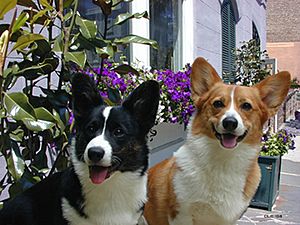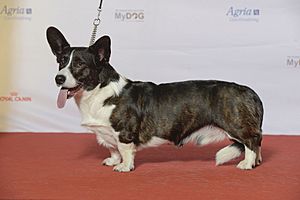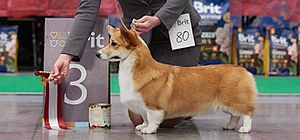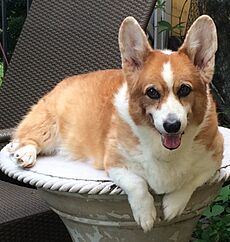Welsh Corgi facts for kids
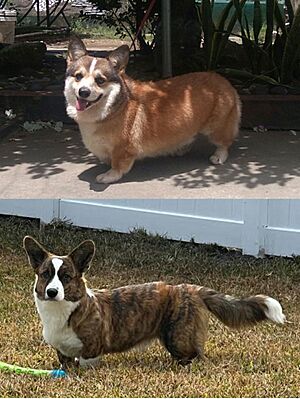
Pembroke and Cardigan Welsh Corgi
|
|||||||||||||||||||||||||
| Origin | Wales | ||||||||||||||||||||||||
|---|---|---|---|---|---|---|---|---|---|---|---|---|---|---|---|---|---|---|---|---|---|---|---|---|---|
|
|||||||||||||||||||||||||
| Domestic dog (Canis lupus familiaris) | |||||||||||||||||||||||||
The Welsh Corgi is a small type of herding dog that comes from Wales. The name corgi means "dwarf dog" in the Welsh language. This is because cor means "dwarf" and ci (which changes to gi) means "dog".
There are two main types of Welsh Corgis: the Pembroke Welsh Corgi and the Cardigan Welsh Corgi. You can tell them apart by a few things. The Cardigan Corgi is usually a bit bigger and has a much longer tail than the Pembroke.
Historically, the Pembroke Corgi might have come to Wales with Flemish weavers around the 14th century. The Cardigan Corgi is thought to be related to dogs brought by Norse settlers, like the Swedish Vallhund.
The Pembroke Corgi is more popular. It became very well known because Elizabeth II, the Queen of England, owned more than 30 of them. She even had Corgi-Dachshund mixes called dorgis.
Contents
Corgi History
Welsh Corgis come from Pembrokeshire and Cardiganshire, two farming areas in South West Wales. These dogs were originally used to herd cattle. They were known as "heelers" because they would nip at the heels of bigger animals to keep them moving. Their short height and quickness helped them avoid getting kicked by the cattle.
Some people believe both Corgi breeds came from the same ancient dog. Others think the Pembroke Welsh Corgi was brought to Wales by Flemish weavers around the 10th century. There are also ideas that Pembrokes might have come from herding dogs in central Europe, possibly related to the Dachshund.
The Cardigan Welsh Corgi is thought to have connections to Nordic settlers. Dogs like the Swedish Vallhund in Scandinavia are similar. This suggests they might share a common ancestor. Later, farmers started raising sheep instead of cattle. Corgis were not as good at herding sheep.
Corgis in Dog Shows
Corgis first appeared in dog shows in Wales in 1925. A group of breeders formed the Welsh Corgi Club. They created a general breed standard, which is a description of what the perfect dog of that breed should look like. Before this, Corgis were not specifically bred for their looks.
At first, the Pembroke and Cardigan types were judged together. There were often disagreements because judges who bred one type might favor their own. The Welsh Corgi first appeared at Crufts, a famous dog show in the UK, in 1927.
In 1934, the Kennel Club officially recognized the Pembroke and Cardigan as two separate breeds. This helped clear up some of the confusion.
Corgi Popularity Over Time
Cardigan Welsh Corgis have always been rarer than Pembrokes. Both breeds survived the Second World War. After the war, Pembroke Corgis became very popular in the United Kingdom. In 1953, they were the fourth most popular breed in the UK.
However, Corgi popularity later went down. In 2006, the Cardigan Welsh Corgi was put on the Kennel Club's list of Vulnerable Native Breeds. This list is for breeds with fewer than 300 new puppies registered in a year. In 2013, the Pembroke Welsh Corgi was also added to this list.
But then, Corgis started becoming popular again! In 2015, there was a big increase in Pembroke registrations. Many people think this was because Corgis became very popular on Instagram. By 2016, Pembrokes were removed from the Vulnerable Native Breeds list.
Corgis in the United States
The first Welsh Corgis came to the United States in 1933. A breeder named Lewis Roesler brought them over. The American Kennel Club (AKC) first registered Welsh Corgis as one breed in 1934.
The Pembroke Welsh Corgi club was formed in the US in 1937. After World War II, more Corgis were brought from the UK. By 1998, the Pembroke Welsh Corgi was the 37th most popular dog breed in the US.
Cardigan Welsh Corgis were also brought to the US, but they have never been as popular as the Pembroke type.
Modern Corgi Breeds
The two types of Welsh Corgis, the Cardigan and the Pembroke, are named after the areas in Wales where they began. Both breeds have similar coats that are water-resistant. They usually shed their fur twice a year.
Both breeds have short legs, which means their bodies are close to the ground. They are not as square-shaped as a Terrier or as long as a Dachshund. Their heads look a bit like a fox's. A Cardigan Corgi's head is usually larger than a Pembroke's, and it has a bigger nose.
Today, Corgis often take part in fun dog activities. These include dog agility trials, obedience competitions, flyball, and herding events. Their natural herding instincts can be tested and trained. In the past, Welsh Corgis were even used to guard children.
Cardigan Welsh Corgi
Cardigans are the larger of the two Corgi breeds. They have big, rounded ears and a long, fox-like tail that flows in line with their body. While Cardigans can have many colors, white should not be the main color of their coat.
The Cardigan has a double coat. The outer coat is thick, a bit rough, and medium length. The undercoat is short, soft, and thick. A Cardigan Corgi usually stands between 10.5 and 12.5 inches (27-32 cm) tall at the withers (the highest part of the back, at the base of the neck). They should weigh between 30 and 38 pounds (14-17 kg).
Cardigans have a wider range of coat colors than Pembrokes. These include different shades of red, sable, and brindle. White markings are common. Black Corgis can have tan or brindle spots. Some Cardigans have "merle" markings, which means patches of different colors.
Pembroke Welsh Corgi
Pembrokes have pointed ears and are a bit smaller than Cardigans. They are smart, strong, and sturdy dogs with enough energy to work all day on a farm. They are usually 10 to 12 inches (25-30 cm) tall at the withers. Male Pembrokes should weigh no more than 30 pounds (14 kg), and females no more than 25 pounds (11 kg).
Their tail is shorter than a Cardigan's. Sometimes, Pembrokes are born with a naturally very short tail (called a bobtail). In the past, if a Corgi didn't have a short tail, it was often made shorter by docking. Now, some countries ban docking, so breeders are trying to breed dogs with natural bobtails again.
Pembrokes have fewer coat colors. These include red, sable, tan, fawn, and black. They can have white markings. Plain white or grey coats are seen, but these are not preferred for dog shows.
Pembroke Welsh Corgis have two coats. The inner coat is shorter and helps protect them from bad weather. The outer coat is rougher and longer, but still medium length. The fur is usually longer and thicker behind their legs and under their bodies. They also have more fur on their chest, neck, and shoulders. Pembroke Corgis do shed their coats.
Corgi Health
Both Corgi breeds have similar average lifespans. They usually live for about 12 years. The main reasons Corgis pass away are cancer and old age. However, Pembroke Corgis sometimes have more issues with kidney failure.
Both breeds can have similar health conditions. One difference is that Pembroke Corgis tend to have more eye problems than Cardigan Corgis. Common eye conditions in Corgis include progressive retinal atrophy (which affects older dogs) and canine glaucoma. Cataracts in Corgis can often be treated with surgery.
Issues related to having puppies, like needing caesarian sections or having false pregnancies, are similar in both breeds. They also have similar rates of muscle and bone problems, like arthritis. However, hip dysplasia, which is common in some dog breeds, is rare in Corgis.
Corgis in Culture
The British Royal Family
Queen Elizabeth II was famous for her love of Corgis. She reportedly said, "my Corgis are family." Her father bought the first royal Corgi, named Dookie, in 1933.
For her 18th birthday in 1944, Princess Elizabeth received her own Pembroke Corgi named Susan. The Queen loved Susan very much. Susan became the ancestor of all the Corgis the royal family later owned. The Queen bred 10 generations of dogs from Susan. She personally owned over 30 Corgis or Corgi/Dachshund mixes (called Dorgis).
The Queen's Corgis had their own room with comfy beds. They were even fed special meals by a chef! In 2018, the last Corgi descended from Susan passed away. However, in 2021, the Queen received two new Corgis named Muick and Sandy. After the Queen passed away in 2022, her son Prince Andrew and his ex-wife took care of Muick and Sandy.
Other Corgi Appearances
Corgis have also appeared in books, movies, and TV shows.
- The American author Tasha Tudor wrote children's books like Corgiville Fair that featured Corgis.
- A Corgi appeared in the 1961 Elvis film Blue Hawaii.
- The 1963 Walt Disney film Little Dog Lost featured a Corgi, which helped make the breed more popular in the US.
- A play based on Roald Dahl's The BFG used several Corgis on stage to play the Queen's dogs.
- The Queen's Corgi is an animated movie about the Queen's Corgis.
- In the anime Cowboy Bebop, there's a super-smart Pembroke Welsh Corgi named Ein.
- The graphic novel Korgi features fairy-like beings and their Corgi friends.
- The royal Corgis even appeared with Queen Elizabeth II and James Bond in the opening ceremony of the 2012 London Olympics.
- The animated TV series Infinity Train has a land of talking Corgis called Coriginia.
- In the American TV show Brooklyn Nine-Nine, the characters Captain Holt and Kevin Cozner own a Pembroke Welsh Corgi named Cheddar.
Images for kids


